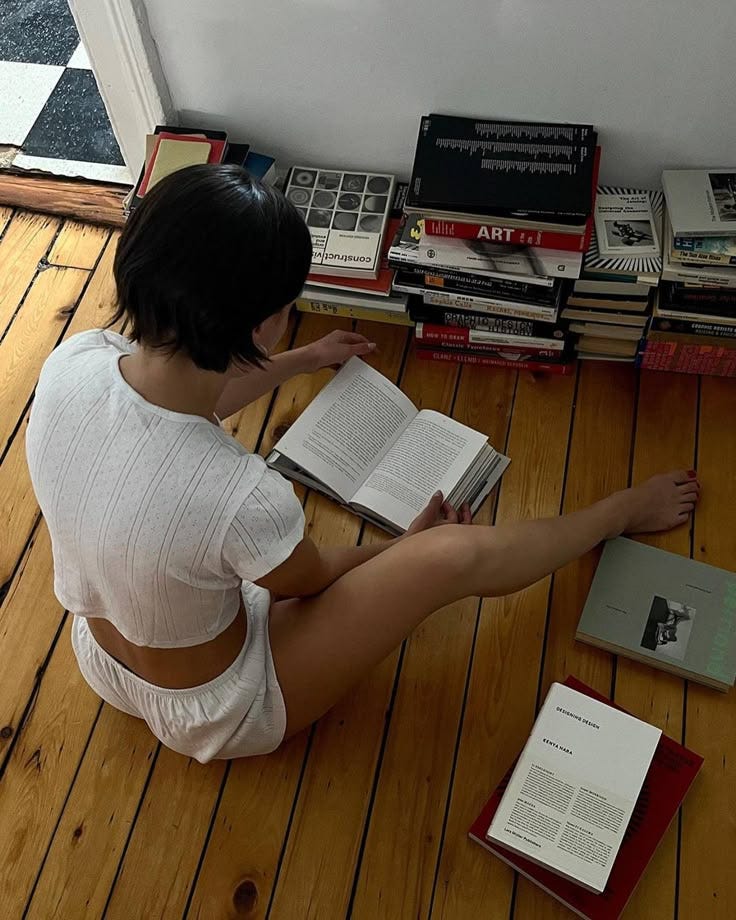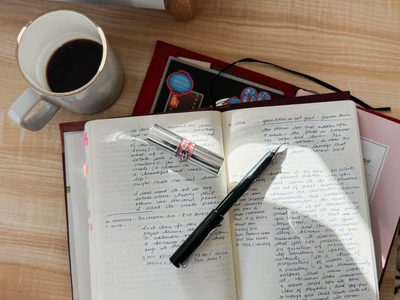The cool girl's guide on stress and burnout

For the modern cool girl, managing stress and burnout isn't about following rigid self-help rules or completely disconnecting from her ambitions. Instead, it's about finding that sweet spot between working towards her goals while still maintaining her sanity (aka what I’m working on currently). Think of it as the art of being both ambitious and mindful—wearing the power suit while having a meditation app on standby if you will.
The cool girl approach to stress management is refreshingly realistic—sometimes it's about the morning yoga session, and other times it's about acknowledging that ordering takeout and watching Netflix is exactly what your mental health needs. It's about understanding that taking care of yourself isn't a sign of weakness, but rather the ultimate power move in building a sustainable, fulfilling life.
Recognizing the signs
The physical
Over the years I’ve learned that burnout looks different for different people. There are also different levels to burning out. Just because I haven’t completely crashed out (yet), doesn’t mean I’m not on my way. (I’ve coined that phenomenon “edging burnout”.)
I swear I’ve been edging burnout since 2020 and only JUST got it under control.
Here are some key physical symptoms that might indicate you're heading towards burnout:
- Persistent fatigue that doesn't improve with rest
- Frequent headaches or muscle tension
- Changes in sleep patterns (insomnia or oversleeping)
- Digestive issues or changes in appetite
- Getting sick more often due to weakened immunity
- Unexplained body aches and pains
Pay special attention if you experience several of these symptoms consistently over time. Your body often signals burnout before your mind fully recognizes it.
The mental
There are also emotional signs that can point to an oncoming burnout. Mind, body, soul sounds woo woo sometimes when I say it aloud, but those 3 aspects of your health are deeply intertwined and each tries to communicate with you when something isn’t right.
Some emotional and mental signs that might indicate burnout:
- Feeling increasingly cynical or negative about work/life
- Difficulty concentrating or brain fog
- Emotional exhaustion or feeling numb
- Increased irritability or short temper
- Loss of motivation or sense of purpose
- Feeling detached from relationships or activities you once enjoyed
- Overwhelming anxiety about tasks that used to feel manageable
- Feeling like you're not making progress despite working constantly
These emotional signs often develop gradually, which is why they can be harder to notice than physical symptoms.
A belief I subscribed to for years was that the cool girl can do it all. They have every aspect of their life on lock without having to break a sweat. Career, relationships, social life, personal life, health, fitness—everything is perfectly in balance.
I’m starting to believe that version of the cool girl is actually detrimental to our wellbeing. Nobody has it all, life just doesn’t work that way. These different areas of our life can’t remain in perfect equilibrium and when you try to push towards that there will come a point when all the balls you’re juggling will start to fall.

So what does the cool girl do to reduce stress and avoid burnout?
While the cool girl does not always have it all together, she does have the tools she needs to keep herself together even when life gets a little heavy. So here’s how we (the new cool girls) are dealing with stress and burnout.
Learning to say no
“Daring to set boundaries is about having the courage to love ourselves, even when we risk disappointing others.” Brené Brown
Saying "no" isn't about being difficult—it's about being strategic with your energy and time. Here's the thing about boundaries: they're not walls, they're guidelines. They help you stay focused on what matters while filtering out what doesn't serve you. Think of them as the VIP list to your energy and time—not everyone and everything gets access.
Some practical ways to set and maintain boundaries:
- Start with small "no's" - Practice saying no to minor requests before tackling bigger ones
- Use the 24-hour rule - Give yourself time to think before committing to new responsibilities
- Keep your responses simple - You don't need to over-explain your boundaries
- Be consistent - People will learn to respect your boundaries when you consistently maintain them
Remember: people might initially push back when you start setting boundaries, especially if they're used to you always saying yes. That's normal. The key is to remain firm but kind—think of it as being assertive, not aggressive.
A cool girl hack I've learned: phrase your boundaries in terms of what you're choosing to prioritize rather than what you're refusing to do. Instead of "I can't take on that project," try "I'm focusing on completing my current commitments with excellence."
The most empowering thing about setting boundaries is that it actually improves your relationships. When you're clear about your limits, you show up as your best self in the moments you do choose to engage. Quality over quantity, always.
Recognize that self-care IS NOT selfish
Self-care comes in a lot of different forms. As I mentioned in How to love yourself (beyond treats & self-care days): “while grand gestures have their place, just like in romantic relationships, real self-love is built in the quieter, less glamorous moments: the hard decisions, the uncomfortable growth, the everyday ways we show up for ourselves.” So while spa days and booking that trip are great ways to treat yourself, we need to also focus on the daily rituals that keep us grounded, centered, and feeling good.
Some little daily rituals that can help keep you grounded without feeling overwhelming:
- Sensory reset: Create a little self-care kit that uses your different senses to get your mind off your stressor. Things like essential oils, a stress ball, or a calming music playlist can all be great sensory signifiers to remind your brain to slow down.
- Micro-movement moments: If you’re having an extra busy day and didn’t have time to schedule in a full workout, try scattering 1-minute movement breaks throughout your day—wall pushups, desk stretches, or maybe a silent dance party? Cool girls definitely dance like no one’s watching.
- Strategic procrastination: Schedule intentional 10-minute "worry sessions" where you allow yourself to stress about everything, then move on. This helps to contain anxiety to specific timeframes rather than let it take over your day. (This also works really well for grief as well.)
I also like to use weekends as a time to reset my mind, body, and soul. Weekend reset routines are crucial for me for maintaining balance and starting each week fresh. Here's what that could look like:
- Sunday planning: Take 30 minutes to review your upcoming week and set intentions
- Home reset: Tackle basic cleaning and organizing to create a clear space and clear mind
- Meal prep: Prepare healthy meals or snacks for the week ahead to reduce daily stress
- Digital declutter: Clear out your inbox, organize your desktop, and delete unnecessary files
Creating healthy mindsets around social media
Maintaining a healthy relationship with technology is another crucial area to pay attention to when it comes to our mental well-being. While social media and digital tools can enhance our lives (heck, I’ve built a career out of it), they can also be a major source of stress and anxiety if not managed properly.
As someone who spends too much time online, here are a few things I’ve implemented over the years to help compartmentalize this area of my life.
Watching your screen time
This is something even I could do better at. Although I don’t scroll social media much anymore, I do spend a lot of time staring at my laptop. Whether I’m researching, writing, editing, communicating—everything happens on a screen. So setting a hard-stop at the end of the work day has helped me a lot.
Creating phone-free zones in your home
I will admit, the only “phone-free” zone in my home is my bed and even that enforced well enough. Something that’s helped is keeping items like a journal and some books on my bedside so that I have other “activities” to turn to before bed. I also set up my phone charger on my dresser on the other side of the room rather than on my bedside table. This way I can just plug my phone in before bed and typically I’ll no longer want to reach for it once I’m cozy.
Having a standalone alarm clock helps as well. I used the excuse “but my phone is my alarm” so much in the past when really I just wanted to have my phone close by. Now I have my Hatch Restore on my bedside instead so I no longer need to reach for my phone first thing.
Reframe your mindset around social media
One of the biggest problems social media seems to create is the act of comparison. Logically we know that the lives we see on socials are unrealistic but mentally it can be hard to distinguish between what’s achievable and what’s for show.
Years ago, I made a pact with myself to reframe how I view other’s content. Instead of seeing it as “what they have that I don’t”, I started to see it as “inspiration for what’s to come.” While I’m not trying to live exactly the way the women I follow are, it can be a fun mindset to have to pick and choose what aspects you want to work towards.
Maybe I do learn about a new bag or a style of apartment that I add to my vision board but that’s as far as the thought goes—it’s adding inspiration and not taking up anymore brain space than that.
I’d love to remind you again: the cool girl isn’t someone who never struggles—she’s someone who learns to navigate life’s messiness with grace, self-awareness, and intention. Burnout and stress will always come and go, especially when you’re ambitious and care deeply about your work and your life. But how we respond—how we slow down, reset, and take care of ourselves in the process—is what sets the new cool girl apart.
We’re not aiming for perfection, we’re aiming for alignment. So if you’ve been feeling overwhelmed lately, take this as your permission slip to pause, re-center, and return to yourself. You don’t have to do it all to be cool. Listen to your body and soul and go at your own pace.






